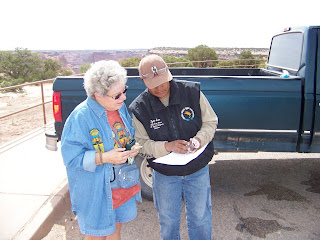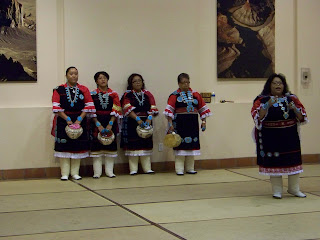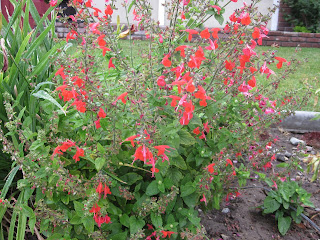Canyon de Chelly (pronounced d'SHAY) is located near Chinle, Az, in the northeast corner of the state. It has been a National Monument, but has recently been named a National Park. According to the park brochure, the canyon "embraces a past of more than 200 million years of geologic history and 2000 years of human history."
The oldest ruins are believed to have be constructed 2000 years ago by the Anasazi (ancient Puebloan people). Many years later they were followed by the Hopi Indians. About 200 years after the Anasazi people migrated, the Navajo Indians first inhabited the canyon. Nobody knows why the earlier groups of people moved on or disappeared, but the canyon is now on the Navajo Indian Reservation which is over 17 million acres.
For many years, Navajo families lived in the canyon, farming and raising animals. Now, nobody lives in the canyon all year, but some people still live there and farm during the summer. The land in the canyon itself has been handed down for as many as 100 generations.
Alan took a guided tour of the canyon floor - you cannot enter the canyon itself without a Navajo guide. The next day, we went to the overlooks on both the south and north rims. These pictures don't begin to do it justice. The beautiful, red sandstone walls just don't show up in pictures as vivid as they are.
This is our "we were there" picture.
These next pictures didn't exactly load in the right order, but it is late so I am just going to go with it.
Rock art - most in the canyon are pictographs (painted) and were done many years ago.
There are also some petroglyphs (carved into the walls). There is no real way to tell, but some experts have theories about what they mean.
The dark stains on the canyon wall, called desert varnish, come from water running down the walls, causing a chemical reaction that deposits manganese in dark streaks. The petroglyphs carved away the dark part, exposing the light rock underneath.
The walls here are about 1000 feet high.
The upper ruins here are about 2000 years old, with the lower ones about 1000 years old.
Many areas have rocks that look like layer upon layer of fine pastry. I wish the pictures showed this better because it was amazing to see.
An example of a farm on the canyon floor. There is a small house or structure at the bottom with fields above it. What looks like a road is actually the river bed. It is dry now except at times of rain or during the monsoon season.
This is Sandy with Darlene Sam, a Navajo Indian who grew up in the canyon. We bought a small handmade pot from her that tells the story of her family. She is explaining the various designs on the pot. There is a spirit line, kind of a broken line, that goes from bottom to top, allowing the bad spirits out and the good spirits in.
We saw quite a few rental RVs and thought this one with the dog painted in the window of the door was really fun.
Karen, this is to show you that little lizards like the ones in your yard also live here.
Friday, May 31, 2013
Saturday, May 25, 2013
Zuni Festival of Arts and Culture
While in Flagstaff on May 25, we went to the Zuni Festival of Arts and Culture at the Museum of Northern Arizona. There were many Zuni artists displaying their creations in beautiful jewelry pieces and fetish carvings. The carvings were small figures (mostly animals) cut from various kinds of stone. These pictures are of the three performances we attended - all very different and really well done.
The Zuni Olla Maidens perform dances that originated with Zuni men since traditionally women did not dance. Their spokeswoman was a kindergarten teacher with a great sense of humor. The traditional leggings and moccasins are put on by dancer's mother until the dancer masters that task. While learning, it can take up to an hour and takes about 15 minutes for the older dancers who have done it for years. Amazing.
If you are a married woman and your in-laws love you, they may give you the turquoise jewelry you wear while dancing. The spokeswoman says she has never married so she had to buy her own jewelry!
As she explained the traditional garb they wear, she said they have several colors of under dresses - "we are such divas!"
In the pottery dances, the pottery is balanced on their heads. It is not fastened in any way. The bottoms are concave and the dancers have developed grooves in their heads over time since the pots are very heavy. It was amazing how much they moved with those pots on their heads.
In the Zuni culture, they speak their language at home, in school and to each other. It is very important to preserve the language. We have heard this before but she said it once again - "If you lose your language, you lose your culture."
Check out this turquoise jewelry. The teacher said they don't wear it all the time or they would have to walk all hunched over. In addition to necklaces, rings and bracelets, the decorations on the skirts were turquoise also, pins, probably.
This little cutie pie was dressed in a traditional dance outfit except for the leggings.
The next performance was by the Zuni Pueblo Band. It has been performing since 1950 and has had varying numbers of members over the years. They are struggling to keep it going and it was interesting that many of these band members were related - even 3 generations of one family. They play Sousa-type march music and they were very good. They are from New Mexico and have played at the NM State Fair and the Fiesta Bowl. Their band director said the Zuni are rich in art, culture and pride, but don't have much money (no casinos). So they requested donations to help keep them going.
These 3 pictures were to show the beautiful jewelry, but the one above, a grandson of one of the band members, shows the mix of cultures - notice the ear buds from his music player hanging around his neck.
The final performance was by the Nawetsa Family Dancers. The family grandfather and one of his sons announced the songs, sang and played the drum. All the other dancers are family members.
These 2 dancers are doing the Eagle Dance - really fun for us since Alan has carved two of them.
These 5 dancers were all grandchildren. They have been working very hard and this was their first performance. They did a great job.
The smallest dancer was so cute - we estimated that he was about 4 years old. These dances go on for a very long time and even the older dancers were tired out, but this little guy was pooped.
This was a son, a daughter and a son-in-law.
This is a sign as you go into the museum, stating "This museum displays ideas, not things."
The Zuni Olla Maidens perform dances that originated with Zuni men since traditionally women did not dance. Their spokeswoman was a kindergarten teacher with a great sense of humor. The traditional leggings and moccasins are put on by dancer's mother until the dancer masters that task. While learning, it can take up to an hour and takes about 15 minutes for the older dancers who have done it for years. Amazing.
If you are a married woman and your in-laws love you, they may give you the turquoise jewelry you wear while dancing. The spokeswoman says she has never married so she had to buy her own jewelry!
As she explained the traditional garb they wear, she said they have several colors of under dresses - "we are such divas!"
In the pottery dances, the pottery is balanced on their heads. It is not fastened in any way. The bottoms are concave and the dancers have developed grooves in their heads over time since the pots are very heavy. It was amazing how much they moved with those pots on their heads.
In the Zuni culture, they speak their language at home, in school and to each other. It is very important to preserve the language. We have heard this before but she said it once again - "If you lose your language, you lose your culture."
Check out this turquoise jewelry. The teacher said they don't wear it all the time or they would have to walk all hunched over. In addition to necklaces, rings and bracelets, the decorations on the skirts were turquoise also, pins, probably.
This little cutie pie was dressed in a traditional dance outfit except for the leggings.
The next performance was by the Zuni Pueblo Band. It has been performing since 1950 and has had varying numbers of members over the years. They are struggling to keep it going and it was interesting that many of these band members were related - even 3 generations of one family. They play Sousa-type march music and they were very good. They are from New Mexico and have played at the NM State Fair and the Fiesta Bowl. Their band director said the Zuni are rich in art, culture and pride, but don't have much money (no casinos). So they requested donations to help keep them going.
These 3 pictures were to show the beautiful jewelry, but the one above, a grandson of one of the band members, shows the mix of cultures - notice the ear buds from his music player hanging around his neck.
The final performance was by the Nawetsa Family Dancers. The family grandfather and one of his sons announced the songs, sang and played the drum. All the other dancers are family members.
These 2 dancers are doing the Eagle Dance - really fun for us since Alan has carved two of them.
These 5 dancers were all grandchildren. They have been working very hard and this was their first performance. They did a great job.
The smallest dancer was so cute - we estimated that he was about 4 years old. These dances go on for a very long time and even the older dancers were tired out, but this little guy was pooped.
This was a son, a daughter and a son-in-law.
This is a sign as you go into the museum, stating "This museum displays ideas, not things."
A California walk in May
We just spent a month with my sister Karen in Upland CA. An earlier blog showcased many of the flowers in her yard. By the end of this visit, a whole new bunch of flowers was blooming. Many mornings, Karen, Bronco (her malamute) and I would walk (stroll really since Bronco is 14) and this is what we would see.
While walking, you have to watch out for these "sticker balls" that fall off the trees. They are everywhere and hard to keep your footing if you step on one.
Back to Karen's yard with her new flag, hummingbird feeder, lizards (there are lots around) and sweet Bronco.
While walking, you have to watch out for these "sticker balls" that fall off the trees. They are everywhere and hard to keep your footing if you step on one.
Back to Karen's yard with her new flag, hummingbird feeder, lizards (there are lots around) and sweet Bronco.
Subscribe to:
Posts (Atom)































































